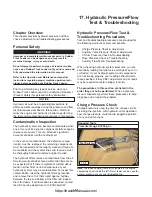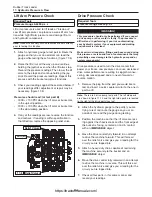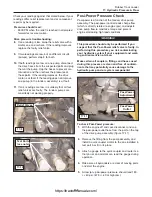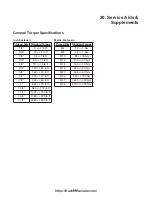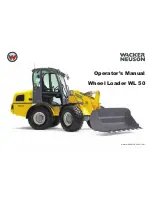
Chapter Overview
This chapter contains basic troubleshooting proce-
dures for the SR-70 and SR-80 Rubber Track Loaders.
Additional troubleshooting aids are provided in Chapter
3 (Circuit Diagrams) and in chapters containing disas-
sembly and assembly procedures for the appropriate
component or assembly.
Personal Safety
Improper or incomplete maintenance/repair of a Rubber
Track Loader can be dangerous and may result in
machine damage, injury or even death.
Do not attempt to perform any type of repair or mainte-
nance on a Rubber Track Loader until you have read and
fully understood the information in this manual.
Refer to the Operation and Maintenance manual for
instructions regarding proper machine operation tech-
niques before operating any Rubber Track Loader.
Prior to performing any type of service work on a
Rubber Track Loader, read and understand Chapter 1
(Product Safety) for personal safety information.
Visual Inspection
Prior to troubleshooting, walk around the machine and
perform an overall visual inspection. Look for missing,
loose, worn or broken parts. Pay particular attention to
the following items:
•
Track tension
•
Fluid levels
•
Fan belt tension and condition
•
Hoses (no visible sign of wear)
•
Fittings (no apparent leaks)
•
Battery cables
•
Fuse panel (fuses in place and operational)
•
Controls (for neutral)
A simple visual inspection and operational check can
identify many problems without the need for extensive
troubleshooting. However, if these checks indicate a
problem that requires further analysis, proceed to
Troubleshooting.
General Troubleshooting
The most effective way to prevent a malfunction from
occurring is to closely follow the recommended mainte-
nance schedule and instructions throughout the life of
the machine. However, if a malfunction does occur,
finding the problem and fixing it quickly are important.
This section covers a select set of symptoms that may
occur and suggests possible causes.
Problem 1:
Machine will not crank over.
Possible causes
1. Continuous high flow switch activated.
2. Continuous low flow switch activated.
3. Power quick-attach switch in unlocked position. (if
equipped)
4. Battery cables loose or corroded.
5. Ignition fuse blown.
6. Main starter fuse blown.
7. Starter relay malfunctioning.
8. Weak or dead battery.
9. Faulty continuous hydraulic flow switch.
10.Faulty power quick attach switch.
11. Faulty ignition switch.
12.Faulty starter.
13.Loose, broken or disconnected wiring at key, relay
or starter.
14.Main power fuse (60-80 amp) blown.
18. Troubleshooting
18-1
!WARNING!
https://tractormanualz.com/
Summary of Contents for ASV SR70
Page 5: ...IV https tractormanualz com...
Page 11: ...1 6 https tractormanualz com...
Page 41: ...4 20 https tractormanualz com...
Page 87: ...12 8 https tractormanualz com...
Page 105: ...14 6 https tractormanualz com...
Page 109: ...15 4 https tractormanualz com...
Page 125: ...16 16 https tractormanualz com...
Page 133: ...17 8 https tractormanualz com...
Page 137: ...18 4 https tractormanualz com...
Page 139: ...19 2 https tractormanualz com...







